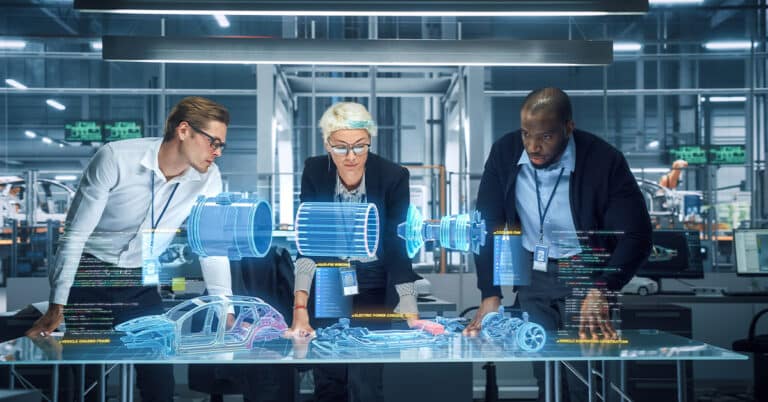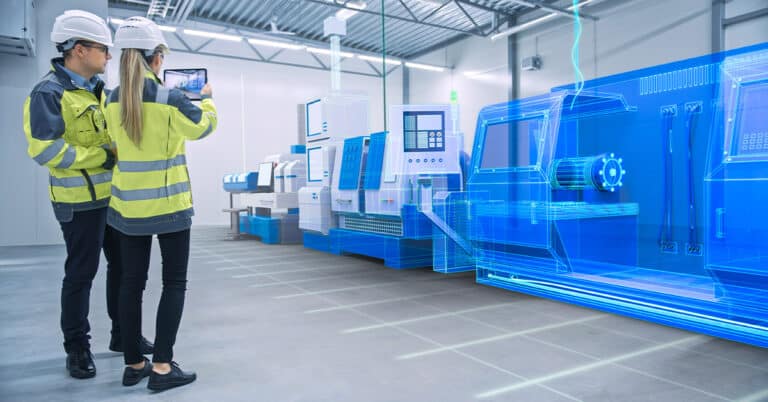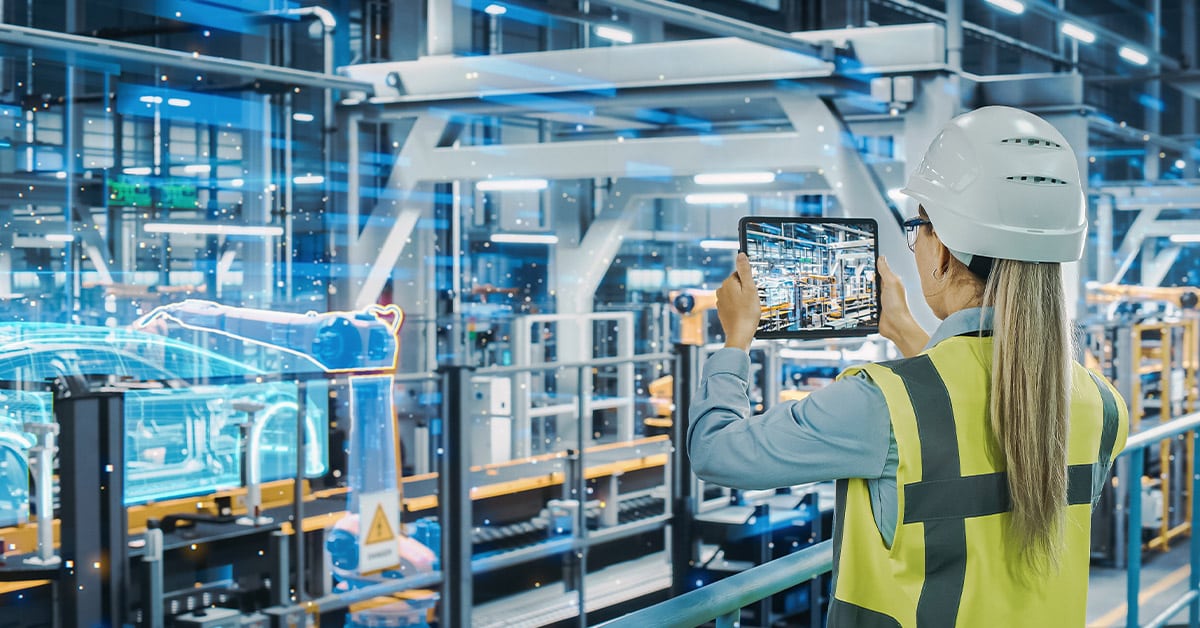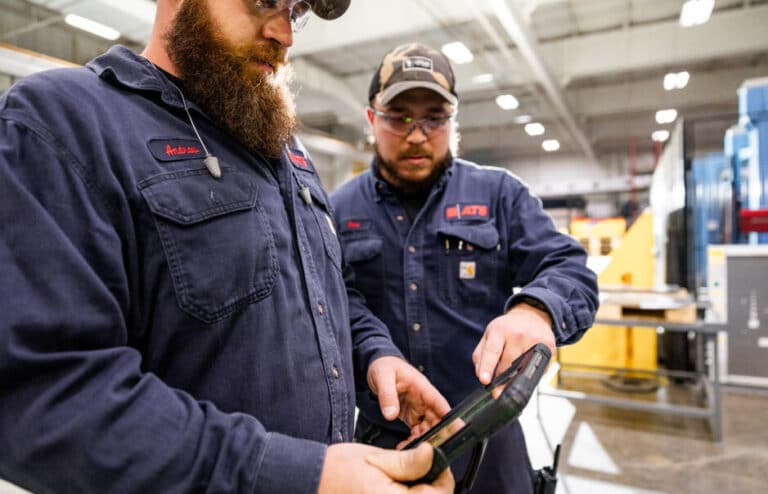Augmented reality is one of the most fascinating subsets of virtual reality technology, and it is fast becoming a highly favored tool among manufacturing maintenance technicians, designers and more. As we’ll explore throughout this article, it is easy to see why. Augmented reality in manufacturing helps personnel accomplish tasks more quickly, improves accuracy and versatility across a number of processes, and can help to reduce costs and improve productivity. Read on to learn more about AR in manufacturing.
Uses of AR in manufacturing
Augmented reality in manufacturing industry applications takes several distinct forms. Here, we will explore four of the most common and effective use cases.
Machinery and Part Visualization: AR overlays can be used to visualize information about a machine, a component or an area of the facility. Uses of AR in these scenarios include displaying internal or external documentation, pictures of equipment, videos, real-time and historical data and more. AR can also draw on real-time data to create models, animations and other tools that can accelerate operational and maintenance processes and help personnel make the right decisions more quickly.
Remote Maintenance & Repair: Augmented reality in maintenance is one of the most promising and effective uses of this technology. With AR, specialists for specific types of equipment and components can provide real-time maintenance support without the need to be on site and, in some cases, facilities can even virtually call-in specialists on a contract basis, reducing the need to keep specialists in every type of equipment on staff. AR in these scenarios works by allowing specialists to see exactly what the on-site technicians sees and walking them through the troubleshooting, diagnostic and repair process, along with supporting information like diagrams, guides and more — all right before the technician’s eyes.
Technician Training & Upskilling: Augmented reality manufacturing training applications enable the most accurate simulation of “hands-on” training yet without the need to bring untrained personnel onto the production line or to shut down production processes for training purposes. With AR, trainees and new hires can experience a 1:1 simulation of their eventual tasks, along with training information and guidance as part of the process. In addition, this technology can be used to upskill existing staff, helping to create a more effective and knowledgeable maintenance workforce without affecting production.
Product Lifecycle Management: Product lifecycle management (PLM) is one of the most effective practices in maximizing the return on capital equipment investments and ensuring that machinery is operating at optimal performance at every stage of its life. With augmented reality, technicians and managers can view lifecycle data, work sequences and historical documentation at a glance, helping to make more faster and effective decisions about maintenance needs, processes, operations and more. In addition, AR enables this information to be communicated anywhere, whether to a central office or simply another area of the facility.
Benefits of AR in manufacturing

Augmented reality offers numerous benefits for manufacturers. These include:
- Enhanced product development: AR can assist in product development in numerous ways, yielding the benefits of a faster design and development cycle with increased versatility and innovation. In product development, AR helps to visualize designs in true 3D, real-world space beyond the capabilities of tools such as CAD software. AR provides the most interactive experience possible and helps design technicians and other personnel to see how components, parts and products fit and operate together. AR at this stage also yields downstream benefits, including more efficient prototyping and earlier insight into production needs.
- Simplify production process: Augmented reality production applications help to centralize complex hardware and software processes into one location — the AR display used by the operator. With AR, operating interfaces can be unified into one delivery method such as headwear or a tablet. The AR display can also provide integrated data, analytics, visualizations and other real-time information that existing hardware cannot.
- Increased collaboration: AR enables remote collaboration across locales and geographies, spurring innovation in more effective ways than ever before. With augmented reality, technicians in different locations can truly interact as if they are physically working alongside one another in a way that legacy technology has not previously been able to replicate. In these scenarios, AR can help with design, troubleshooting, problem-solving and other areas, facilitating true collaborative efforts that draw on the expertise of personnel throughout the organization no matter where they are located.
- Lower operating costs: With all of the above benefits and applications, the end goal is cost reduction — and AR delivers. By enabling faster decision-making with more effective results, AR increases the productivity and success of personnel throughout the organization, from technicians to management. AR can yield more streamlined designs, more efficient production processes and more effective, proactive maintenance with lower resource usage, all of which create measurable cost benefits for the bottom line.
Types of AR solutions for manufacturing

There are three primary types of AR solutions and delivery systems for manufacturing. They are:
Tablets and Mobile Devices: With the right software installed, tablets and mobile devices can deliver AR solutions, making use of the device camera along with the tablet or mobile display and interface that nearly all workers are familiar with. The ease of adoption is the primary benefit of this solution, while the consumer-grade hardware can limit some of the effectiveness of AR delivered through these methods.
Wearable Technology: Most frequently used as a wearable set of goggles or glasses, wearable AR technology helps to enable some of the most powerful applications of these tools, including maintenance, collaboration and visualization. Wearable technology is a very common AR solution, providing real-time, heads-up information at a glance.
Projected Systems: Projected systems use projector hardware along with vision sensors to display AR information onto any surface — a wall, a desk or even a floor. The primary benefit of this solution is its versatility and its enablement of collaboration between on-site colleagues.
With expertise in predictive technologies and a track record of delivering reduced downtime and improved asset reliability, ATS is a leader in technology-driven industrial maintenance. We are ready to assist you in determining the right technology and strategy implementation to achieve your operational goals. To learn more, contact us today.


